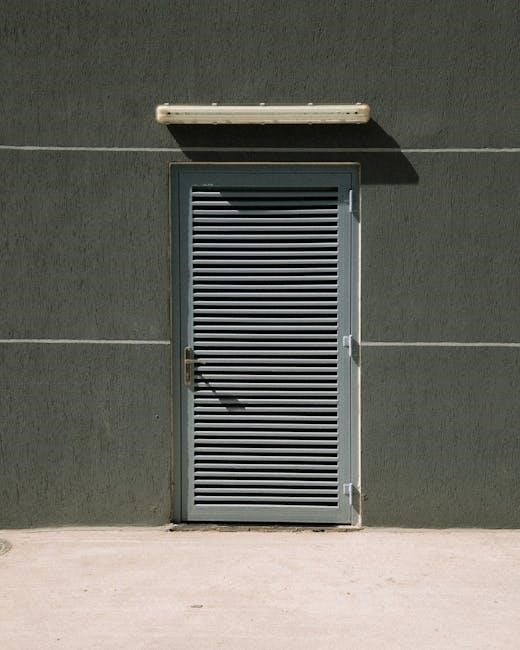Blum hinges are renowned for their reliability, durability, and innovative design, offering smooth operation and precise adjustment. They are ideal for various cabinet door applications, ensuring long-lasting performance.
Overview of Blum Hinges and Their Benefits
Blum hinges are engineered for exceptional performance and versatility, offering sleek designs and silent operation. Their innovative mechanisms ensure smooth door closure and precise alignment. With features like tool-free assembly and three-dimensional adjustment, they provide convenience and flexibility. Blum hinges are ideal for various applications, from standard cabinets to specialized configurations, making them a preferred choice for furniture makers and homeowners seeking durability and functionality. Their commitment to sustainability further enhances their appeal in modern designs.

Preparation for Installation
Ensure door thickness meets specifications (16-24 mm). Gather essential tools like a 35mm Forstner bit and INSERTA tool. Plan hinge placement for proper alignment and functionality.
Door Thickness Requirements (16 mm to 24 mm)
Blum hinges are designed for doors with a thickness range of 16 mm to 24 mm, ensuring proper fitting and functionality. Doors outside this range may not align or operate correctly. Standard applications typically use 16-22 mm thickness, while thicker doors up to 24 mm require specific adjustments. Proper door thickness is crucial for hinge performance and durability, ensuring smooth operation and long-lasting reliability.
Recommended Number of Hinges Based on Door Size
Blum hinges are designed to ensure optimal performance based on door size. For doors up to 700 mm in height, one pair of hinges is sufficient. Doors between 701 mm and 1500 mm require three hinges, while doors up to 2000 mm in height need four hinges. This ensures proper weight distribution, stability, and alignment, guaranteeing smooth operation and durability over time.

Mounting Plate Installation
Mounting plates are crucial for securing Blum hinges, ensuring proper alignment and stability. They must be installed precisely, aligning with the hinge arm to guarantee smooth door operation.
Aligning the Mounting Plate with the Hinge Arm

Proper alignment of the mounting plate with the hinge arm is essential for smooth door operation. Ensure the plate’s lugs fit securely into the recesses beneath the hinge arm. This step guarantees precise movement and prevents misalignment issues.
Use a level to confirm the door is even, then attach the hinge to the mounting plate. Rotate the door gently to secure the connection, ensuring the hinge arm aligns perfectly with the plate for optimal functionality.

Securing the Hinge to the Mounting Plate
To secure the hinge to the mounting plate, align the hinge arm with the plate’s recesses. Gently rotate the door to ensure the lugs on the plate fit into the hinge’s recesses. Tighten the screws firmly, applying even torque to avoid misalignment. Use a screwdriver or the INSERTA tool for precise tightening, ensuring the hinge is firmly attached for smooth operation.
Hinge Cup Installation
Drill a 35mm diameter hole, 13mm deep, using a Forstner bit. Ensure the bit is square to the door for accurate hinge cup placement and alignment.
Drilling Hinge Cup Holes (35mm Diameter, 13mm Deep)
Drill a 35mm diameter hole, 13mm deep, using a Forstner bit for precise, flat-bottomed holes. Ensure the bit is square to the door to maintain accurate alignment. The hole should be centered 22.5mm from the door’s edge for standard applications. This step is critical for proper hinge cup installation, as it ensures the hinge operates smoothly and conceals the mounting hardware. Use a drill guide or template for consistent results; Avoid drilling deeper than specified to prevent door damage. This precise drilling ensures proper hinge alignment and functionality.
Gap Calculation Between Hinge Cup and Cabinet Edge
The gap between the hinge cup and cabinet edge is crucial for proper door alignment. The factory setting for the door gap is typically 1.5 mm, measured from the back of the door to the front of the side panel or frame. This gap ensures smooth operation and prevents doors from catching. Use Blum templates or guides for accurate measurement, especially for specialized applications like blind corners or partial overlays. Adjustments can be made using the hinge’s built-in screws to achieve the desired fit and ensure optimal functionality.
Vertical and Horizontal Adjustment
Blum hinges feature adjustment screws for precise vertical and horizontal alignment. These screws allow fine-tuning of the door’s height and depth for optimal performance and alignment.
Adjusting the Height and Depth of the Hinges
Adjusting the height and depth of Blum hinges ensures proper door alignment. Use the adjustment screws to fine-tune the vertical and horizontal positions. Turning the screws clockwise or counterclockwise modifies the hinge’s position. Ensure the door is parallel to the cabinet for optimal performance. Proper alignment prevents gaps and ensures smooth operation. Adjustments are tool-free, allowing for effortless customization. This feature enhances the overall functionality and longevity of the hinges, ensuring doors open and close seamlessly.
Cam Side Adjustment for Proper Alignment

Cam side adjustment ensures precise alignment of Blum hinges. The cam mechanism allows for fine-tuning the hinge’s position. By turning the adjustment screws, you can adjust the door’s alignment horizontally and vertically. Proper cam adjustment ensures the door is flush with the cabinet, eliminating gaps. This feature enhances the door’s stability and ensures smooth, consistent operation. Adjustments are made without tools, making it easy to achieve perfect alignment and maintain the hinge’s durability over time.

Specialized Applications
Blum hinges cater to unique applications, including blind corners and partial/twin overlays. These solutions optimize space and ensure smooth operation in complex cabinet configurations, enhancing functionality and design.
Blind Corner Hinge Installation
Blind corner hinges are designed for applications where doors meet at a right angle, optimizing space and accessibility. Installation requires precise alignment of the hinge arm and mounting plate. Use Blum’s templates for accurate drilling of 35mm diameter holes, 13mm deep. Ensure the hinge cup is flush with the cabinet edge, maintaining the factory-set gap. Secure the hinge to the mounting plate by aligning lugs with recesses and gently rotating the door. This configuration ensures smooth, space-saving operation in corner applications.
Partial/Twin Overlay Door Configurations
Partial and twin overlay configurations require precise hinge placement to ensure proper alignment and smooth operation. For partial overlay doors, the hinge cups are installed using a 35mm Forstner bit, drilling 13mm deep holes, ensuring the bit remains square to the door. The gap between the hinge cup and cabinet edge is typically 1.5mm, adjustable as needed. In twin overlay setups, hinges must be offset correctly so doors align perfectly when closed. Blum templates aid in accurate marking, and tools like the INSERTA facilitate tool-free assembly. Adjustments for height, depth, and cam side ensure optimal performance, while deactivating BLUMOTION may be necessary for specific configurations. Proper screw tightening is essential to avoid damage and ensure smooth functionality.

Tools and Accessories
Essential tools include a 35mm Forstner bit for hinge cup holes, INSERTA tool for tool-free assembly, and Blum templates for precise drilling and alignment, ensuring accuracy and efficiency.
Essential Tools for Installation (Forstner Bit, INSERTA Tool, etc.)
The 35mm Forstner bit is crucial for drilling hinge cup holes precisely and evenly. The INSERTA tool enables tool-free assembly of hinge components, while Blum templates ensure accurate alignment and drilling. These tools are designed to streamline the installation process, reducing errors and saving time. They work seamlessly with Blum hinges, ensuring a professional finish and reliable performance. Proper use of these tools is essential for achieving the desired results in cabinet door installations.

Using Blum Templates for Accurate Assembly
Blum templates are designed to simplify the installation process by providing precise markings for hinge cup holes and mounting plate positions. They ensure accurate alignment, minimizing the risk of measurement errors. These templates work seamlessly with tools like the Forstner bit and INSERTA tool, helping to achieve professional results. By following the template guidelines, installers can efficiently assemble Blum hinges, ensuring a precise fit and proper functionality. This approach saves time and guarantees consistent, high-quality outcomes.
Troubleshooting Common Issues
Common issues include door misalignment and BLUMOTION deactivation. Adjust hinges vertically or horizontally for proper alignment. Refer to the manual for deactivating BLUMOTION smoothly.
Door Misalignment and Adjustment Solutions
Door misalignment can occur due to improper hinge installation or wear over time. To fix this, adjust the hinge arm using the adjustment screw, ensuring proper alignment with the mounting plate. For minor issues, tighten or loosen the screws gently. If the door is severely misaligned, reattach it using the CLIP mechanism. Refer to the manual for detailed guidance on vertical and horizontal adjustments to achieve seamless door operation and ensure longevity of the hinges.
Deactivating the BLUMOTION Feature
To deactivate the BLUMOTION soft-close feature, first ensure the door is removed or fully open. Locate the adjustment screw on the hinge arm and turn it counterclockwise until resistance is felt. This disables the soft-close mechanism. For permanent deactivation, remove the BLUMOTION damper using an Allen wrench. Note that deactivating this feature may affect the smooth closing functionality. Refer to the manual for detailed steps to ensure proper adjustment and maintain hinge performance.
Environmental Considerations
Blum has been committed to environmental protection for decades, prioritizing sustainable practices and eco-friendly solutions in their hinge manufacturing processes to minimize ecological impact.
Blum’s Commitment to Sustainability
Blum has demonstrated a strong commitment to sustainability by implementing eco-friendly manufacturing processes and using materials that minimize environmental impact; Their focus on energy efficiency and waste reduction ensures responsible production. Additionally, Blum’s durable and long-lasting hinge systems reduce the need for frequent replacements, further supporting environmental conservation. By prioritizing sustainable practices, Blum contributes to a greener future while maintaining high-quality furniture fittings.
Blum hinges offer exceptional durability and ease of installation, ensuring long-lasting performance. By following these instructions, you can achieve professional results and enjoy smooth, reliable door operation.
Final Tips for Successful Hinge Installation
For a flawless installation, use the correct tools like the Forstner bit and INSERTA tool. Ensure precise alignment of the hinge arm and mounting plate. Apply even torque to screws to avoid misalignment. Double-check door thickness and hinge compatibility. Utilize Blum templates for accuracy. Adjust hinges methodically, starting with height, then depth, and finally the cam side. Test door operation after each adjustment. Properly deactivate BLUMOTION if needed. Follow these steps to achieve smooth, durable, and professional results. Blum’s commitment to sustainability ensures eco-friendly solutions.

No Responses